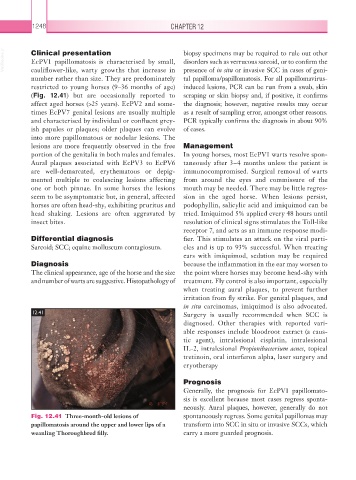Page 1273 - Equine Clinical Medicine, Surgery and Reproduction, 2nd Edition
P. 1273
1248 CHAPTER 12
VetBooks.ir Clinical presentation biopsy specimens may be required to rule out other
disorders such as verrucous sarcoid, or to confirm the
EcPV1 papillomatosis is characterised by small,
cauliflower-like, warty growths that increase in
tal papilloma/papillomatosis. For all papillomavirus-
number rather than size. They are predominately presence of in situ or invasive SCC in cases of geni-
restricted to young horses (9–36 months of age) induced lesions, PCR can be run from a swab, skin
(Fig. 12.41) but are occasionally reported to scraping or skin biopsy and, if positive, it confirms
affect aged horses (>25 years). EcPV2 and some- the diagnosis; however, negative results may occur
times EcPV7 genital lesions are usually multiple as a result of sampling error, amongst other reasons.
and characterised by individual or confluent grey- PCR typically confirms the diagnosis in about 90%
ish papules or plaques; older plaques can evolve of cases.
into more papillomatous or nodular lesions. The
lesions are more frequently observed in the free Management
portion of the genitalia in both males and females. In young horses, most EcPV1 warts resolve spon-
Aural plaques associated with EcPV3 to EcPV6 taneously after 3–4 months unless the patient is
are well-demarcated, erythematous or depig- immunocompromised. Surgical removal of warts
mented multiple to coalescing lesions affecting from around the eyes and commissure of the
one or both pinnae. In some horses the lesions mouth may be needed. There may be little regres-
seem to be asymptomatic but, in general, affected sion in the aged horse. When lesions persist,
horses are often head-shy, exhibiting pruritus and podophyllin, salicylic acid and imiquimod can be
head shaking. Lesions are often aggravated by tried. Imiquimod 5% applied every 48 hours until
insect bites. resolution of clinical signs stimulates the Toll-like
receptor 7, and acts as an immune response modi-
Differential diagnosis fier. This stimulates an attack on the viral parti-
Sarcoid; SCC; equine molluscum contagiosum. cles and is up to 93% successful. When treating
ears with imiquimod, sedation may be required
Diagnosis because the inflammation in the ear may worsen to
The clinical appearance, age of the horse and the size the point where horses may become head-shy with
and number of warts are suggestive. Histopathology of treatment. Fly control is also important, especially
when treating aural plaques, to prevent further
irritation from fly strike. For genital plaques, and
in situ carcinomas, imiquimod is also advocated.
12.41 Surgery is usually recommended when SCC is
diagnosed. Other therapies with reported vari-
able responses include bloodroot extract (a caus-
tic agent), intralesional cisplatin, intralesional
IL-2, intralesional Propionibacterium acnes, topical
tretinoin, oral interferon alpha, laser surgery and
cryotherapy
Prognosis
Generally, the prognosis for EcPV1 papillomato-
sis is excellent because most cases regress sponta-
neously. Aural plaques, however, generally do not
Fig. 12.41 Three-month-old lesions of spontaneously regress. Some genital papillomas may
papillomatosis around the upper and lower lips of a transform into SCC in situ or invasive SCCs, which
weanling Thoroughbred filly. carry a more guarded prognosis.

